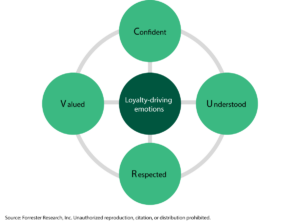The Emotions And Moments In The Customer Journey That Really Drive Loyalty
Emotion is key to differentiated experiences that drive customer loyalty. But many companies get emotion wrong. Rather than designing experiences built on a broad spectrum of emotions, they equate emotion with delight.
Contrary to popular belief, making customers feel content, happy, or delighted impacts loyalty less than making customers feel respected, understood, valued, or confident. Satisfaction does not necessarily drive loyalty. Making customers feel happy or content can increase their satisfaction with an experience. But while satisfaction is desirable, it is not sufficient to drive loyalty. Satisfied customers leave companies despite being satisfied. Relying on customers being satisfied might mask deeper problems.
We need to think more broadly about the emotions that drive customer loyalty. Each of our emotions has its own individual message and purpose. Your customers are going to experience a range of emotions.

Combining Journeys And Emotion Is Powerful Because It Helps Us See Emotions Paired With The Context
Events shape our emotions, and our emotions shape events. We need to be careful about taking emotions at face value without contextualizing them in the customer journey. Combining journeys and emotion is powerful because it helps us see emotions paired with the context — the sets of interactions and events — that triggered and shaped those emotions. Our job is to fine-tune the moments that customers will be most likely to remember. We need to see emotions in context, and we need to understand behaviors, events, and end-to-end journeys. To elicit loyalty-driving emotions in the moments that matter:
- Increase confidence when customers are trying to understand your product. Many companies strive for experiences that are seamless, easy, or beautiful, but few emphasize giving their customers or users confidence that they’ve made the right choice or reached the right place. Clear communication is key. Avoid jargon and include all information that customers need to make a decision. Encourage customers to leave and view ratings and reviews. Reviews often include information about other customers’ end-to-end journeys — including information about shipping, unboxing, and the actual use of the product — that help set realistic expectations and boost customers’ confidence that the product, service, or experience will fit their needs.
- Optimize the payment process to boost confidence and avoid disappointment. Paying is a critical moment in journeys that involve buying a product. Reassure customers as they input information. Entering payment information on the bank’s page can increase confidence, helping customers complete the purchase. Make sure the process is easy and effective. Avoid disappointment at the end of the journey when the customer is paying or trying to redeem a coupon or promotion.
- Protect customers’ personal data and value their time to make them feel respected. Focusing on privacy helps some customers feel respected and valued, especially for high-value transactions or when sharing sensitive data. Privacy is particularly important for more complex journeys, where customers are likely willing to exchange more information in return for a more personalized product.
- Focus on sustainability and recyclability to boost feelings of worthiness. Focus on sustainability and recyclability throughout the journey — from communicating about sustainable practices to understanding consumer preferences for environmentally friendly delivery options to considering how customers dispose of packaging. By focusing on moments like the sustainability and the recyclability of packaging, companies contribute to a sense of worthiness and make customers feel that they can make purchase decisions that align with their values.
For more information, see the full Forrester report or schedule an inquiry with us for more information.
